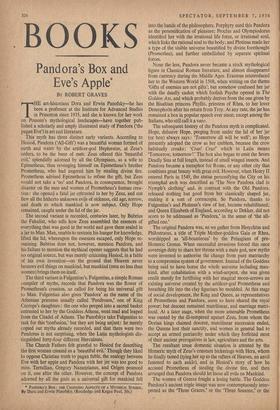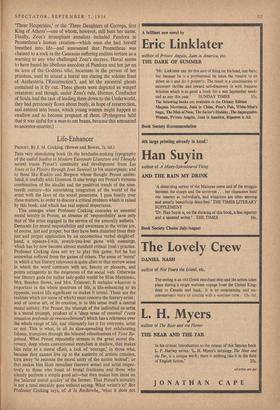Pandora's Box and
BY ROBERT GRAVES THE art-historians Dora and Erwin Panofsky—he has been a professor at the Institute for Advanced Studies in Princeton since 1935, and she is known for her work on Poussin's mythological landscapes—have together pub- lished a scholarly and amply illustrated study of Pandora (`the pagan Eve') in art and literature.
This myth has three distinct early variants. According to Hesiod, Pandora (`All-Gift') was a beautiful woman formed of earth and water by the artificer-god Hephxstus, at Zeus's orders, to be the bane of men. Zeus offered this 'beautiful evil,' splendidly adorned by all the Olympians, as a wife to Epimetheus, thus revenging himself on Epimetheus's brother Prometheus, who had angered him by stealing divine fire. Prometheus advised Epimetheus to refuse the gift, but Zeus would not take a 'no' and Pandora, in consequence, brought disaster on the men and women of Prometheus's human crea- tion : she opened a fatal jar entrusted to her by Zeus, and out flew all the hitherto unknown evils of sickness, old age, sorrow. and death to which mankind is now subject. Only Hope remained, caught under the lid of the jar.
The second variant is recorded, centuries later, by Babrius the Fabulist, who tells how Zeus assembled the essences of everything that was good in the world and gave them sealed in a jar to Man. Man, unable to restrain his hunger for knowledge, lifted the lid, whereupon the essences escaped, only Hope re- maining. Babrius does not, however, mention Pandora, and his failure to mention the mythical opener suggests that he bad no original source, but was merely criticising Hesiod, in a fable of his own invention—on the ground that Heaven never bestows evil things on mankind, but mankind (men no less than women) brings them on itself. into the hands of the philosophers. Porphyry used this Pandora as the personification of pleasure; Proclus and Olympiodorus identified her with the irrational life force, or irrational soul, which links the rational soul to the body; and Plotinus made her a type of the visible universe beautified by divine forethought (Pronzethea), and further embellished by separate spiritual forces.
None the less, Pandora never became a stock mythological figure in Classical Roman literature, and almost disappeared from currency during the Middle Ages. Erasmus reintroduced her to the Western World in 1508, when writing on the theme `Gifts of enemies are not gifts'; but somehow confused her jar with the deadly casket which foolish Psyche opened in The Golden Ass, and which probably derives from the one given by the Bisaltian princess Phyllis, priestess of Rhea, to her lover Dernophoon after his return from Troy. At any rate, the jar has remained a box in popular speech ever since; except among the Italians, who still call it a vaso.
The subsequent history of the Pandora myth is complicated. Hope, delusive Hope, peeping from under the lid of her jar (or box) always says : 'Tomorrow all will be well'; so Hope presently adopted the crow as her emblem, because the crow habitually croaks : `Cras! Cras!' which in Latin means `Tomorrow, tomorrow!' The box also began to emit the Seven Deadly Sins at full length. instead of small winged insects. And Pandora became a metaphor for Rome, or any other city that combines great beauty with great evil. However, when Henry II entered Paris in 1549, the statue personifying the City on his triumphal arch was described as 'The New Pandora clad in Nymph's clothing' and, in contrast with the Old Pandora, released nothing but good from her classically shaped jar, making it a sort of cornucopia. So Pandora, thanks to Fulgentius's and Plotinus's view of her, became rehabilitated; and Queen Elizabeth of England, according to Dekker, did not scorn to be addressed as 'Pandora,' in the sense of 'the all- gifted one.'
The original Pandora was, so we gather from Hesychius and Philostratus, a title of Triple Mother-goddess Gaia or Rhea, worshipped as 'all-bounteous' by the Pelasgians of pre- Homeric Greece. When successful invasions forced this once sovereign deity to share her throne with a male god, new myths were invented to authorise the change from pure matriarchy to a compromise system of government. Instead of the Goddess being said to have borne the whole universe including man- kind, after cohabitation with a wind-serpent, she was given credit merely for fertilising with her magical moon-arrows an existing universe created by the artificer-god Prometheus and breathing life into the clay figurines he moulded. At this stage of social development, the King and Queen, as representatives of Prometheus and Pandora, seem to have shared the royal power; but descent remained matrilinear, and marriage matri- local. At a later stage, when the more amenable Prometheus was ousted by the ill-tempered upstart Zeus, from whom the Dorian kings claimed descent, matrilinear succession ended. the Queens lost their sanctity, and women in general had to accept an armed patriarchy under which they forfeited most of their ancient prerogatives in law, agriculture and the arts.
The resultant tense domestic situation is attested by the Homeric myth of Zeus's constant bickerings with Hera, whom he finally tamed (tying her up to the rafters of Heaven, an anvil fastened to each ankle), and in Hesiod's story of how he accused Prometheus of stealing the divine fire, and then arranged that Pandora should let loose all evils on Mankind. `Three Hesperides,' or the 'Three Daughters of Cecrops, first , King of Athens'—one of whom, however, still bore her name. Finally, Zeus's triumphant annalists included Pandora in Prometheus's human creation—which once she had herself breathed into life—and announced that Prometheus was chained to a rock in the Caucasus suffering endless torture as a warning to any who challenged Zeus's decrees. Herod seems to have based his libellous anecdote of Pandora and her jar on an icon of the Goddess who, incarnate in the person of her priestess, used to unseal a burial urn during the solemn feast of Anthesteria ('Resurrection'), and let the ancestral ghosts contained in it fly out. These ghosts were depicted as winged creatures; and though, under Zeus's rule, Hermes, Conductor of Souls, had the task of leading them down to the Underworld, they had previously flown about freely, in hope of resurrection, and entered into beans, which young women might happen to swallow and so become pregnant of them. (Pythagoras held that it was sinful for a man to eat beans, because this amounted to ancestor-murder.)



































 Previous page
Previous page